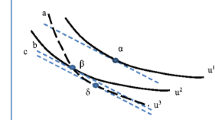Abstract
This paper develops an empirical framework for taking into account the effects of endogenous liquidity on price capitalization estimates. Changes in school attendance zones in the East Baton Rouge Parish public school district provide a natural experiment for studying how changes in school characteristics affect house prices and liquidity. House price and selling time, or liquidity, are simultaneously determined in search markets. The empirical model exploits variation in the surrounding neighborhood market conditions pertinent to each house to identify the system of price and liquidity equations. The estimates are consistent with search-market theory in that liquidity absorbs part of the capitalization of school quality.
Similar content being viewed by others
Notes
The extra waiting time is required to increase the cumulative likelihood of a (low frequency) idiosyncratic buyer who values the house more than the average buyer in the market.
Krainer (2001) establishes an empirical link between days on the market and variables such as the interest rate, the slope of the term structure, and the job growth rate.
We focus on elementary schools because only these schools allow for enough within-district variation to conduct empirical analysis. In any event, schools with grades 9–12 and 9–12 portions of K–12 schools (i.e., high school and combination schools) officially entered the Louisiana School Accountability System in 2001, making their school quality measures unavailable for most of our sample period.
The subject area covers a contiguous region and excludes houses in the separate small cities of Baker and Zachary, the only parts of East Baton Rouge Parish that are not within the unified City-Parish jurisdiction.
All schools also receive an annual growth target and are expected to reach a target score by the 2013–2014 school year.
Private school enrollment data comes from National Center of Education Statistics’ (NCES) Common Core Data (CCD).
These dummies capture the growth SPS or lack thereof over time in student achievement. These measures are consistent with the value added approach that education and labor economists argue is a better measure of school quality than just proficiency test results (Hanushek and Taylor 1990; Meyer 1997; Figlio 1999). We assume that it is difficult for parents to notice a small change in the level values of test scores; a school that is improving has a difficult time signaling that improvement to the buyers in the housing market. The Louisiana Department of Education started publishing for parents the School Report Card that presented the categorical ranking of a school and its growth target as well as its performance relative to other schools in the district. We believe that this information gives parents better understanding of how their local school performs.
Norris (2002) data covers six parishes with large shares of ethnic minorities, blacks in particular, but does not include East Baton Rouge Parish.
Recall that our focus on the impact of changes in school assignments (attendance zone boundaries) and changes in school categorical rankings on house prices requires that we use the full jurisdiction data, so we do not restrict our attention to boundary samples.
These results are available from the authors.
There are only a few studies that take into account the effect of the housing stock adjustment (Edel and Sclar 1974; Hilber and Mayer 2001, 2002; Brasington 2002). For example Brasington (2002) finds that public services are always capitalized into house values at a considerably stronger rate toward the interior of the urban area than toward the edge, where developers are more active and the housing supply is more elastic.
Areas with active new housing construction normally would be areas with new school construction as well. In such cases, that fact, by itself, might yield higher school quality. However, this is not true in Baton Rouge. There was no new school construction for the time period we consider. The average age of a school in East Baton Rouge Parish is more than 40 years.
References
Anglin, P. M., Rutherford, R., & Springer, T. M. (2003). The trade-off between the selling price of residential properties and time-on-the-market: The impact of price setting. Journal of Real Estate Finance and Economics, 26(1), 95–111.
Arnott, R. (1989). Housing vacancies, thin markets, and idiosyncratic tastes. Journal of Real Estate Finance and Economics, 2(1), 5–30.
Asabere P. K., Huffman F. E., & Mehdian S. (1993) Mispricing and optimal time on the market. Journal of Real Estate Research, 8(1), 149–155.
Belkin, J., Hempel, D. J., & McLeavey, D. W. (1976). An empirical study of time on market using multidimensional segmentation of housing markets. American Real Estate and Urban Economics Association Journal, 4(2), 57–75.
Black, S. (1999). Do better schools matter? Parental valuation of elementary education. Quarterly Journal of Economics, 114(2), 579–599.
Brasington, D. M. (2002). Edge versus center: Finding common ground in the capitalization debate. Journal of Urban Economics, 52(3), 524–641.
Brasington, D. M., & Haurin D. R. (2006). Educational outcomes and house values: A Test of the value added approach. Journal of Regional Science, 46(2), 245–268.
Case, K. E., & Shiller, R. J. (2003). Is there a bubble in the housing market?: Brookings Panel on Economic Activity.
Clapp, J. M., Nanda, A., & Ross, S. L. (2004). Test-Scores and demographics: What premiums do they attract in property values? A Panel data analysis, Working Paper, University of Connecticut, Department of Economics.
Edel, M., & Sclar, E. (1974). Taxes, spending, and property values: supply adjustment in a Tiebout–Oates Model. Journal of Political Economy, 82(5), 941–954.
Figlio, D. N. (1999). Functional form and the estimated effects of school resources. Economics of Education Review, 18(2), 241–252.
Figlio, D. N., & Lucas, M. E. (2004). What’s in a grade? School report cards and house prices: American Economic Review, 94(3), 591–604.
Fischel, W. A. (2001). The Homevoter Hypothesis. Cambridge, MA: Harvard University Press.
Fisher, J., Gatzlaff, D., Geltner, D., & Haurin, D. (2003). Controlling for the impact of variable liquidity in commercial real estate price indices. Real Estate Economics, 31(2), 269–303.
Forgey, F. A., Rutherford, R. C., & Springer, T. M. (1996). Search and liquidity in single-family housing. Real Estate Economics, 24(3), 273–292.
Genesove, D., & Mayer, C. J. (1997). Equity and time to sale in the real estate market. American Economic Review, 87(3), 255–269.
Genesove, D., & Mayer, C. J. (2001). Loss aversion and seller behaviour: evidence from the housing market. Quarterly Journal of Economics, 116(4), 1233–1260.
Hanushek, E. A., & Taylor, L. L. (1990). Alternative assessments of the performance of schools: Measurement of state variations in achievement. The Journal of Human Resources, 25(2),179–201.
Haurin, D. R. (1988). The duration of marketing time of residential housing. American Real Estate and Urban Economics Association Journal, 16(4), 396–410.
Haurin, D. R., & Brasington, D. (1996). School quality and real house prices: inter- and intrametropolitan effects. Journal of Housing Economics, 5(4), 351–368.
Hayes, K. J., & Taylor, L. T. (1996). Neighborhood school characteristics: What signals quality to homebuyers?: Federal Reserve Bank of Dallas Economic Review, 3, 2–9.
Hilber, C. A. L., & Mayer, C. J. (2001). Land supply, house price capitalization, and local spending on schools (Working paper #392): University of Pennsylvania.
Hilber, C. A. L., & Mayer, C. J. (2002). Why do households without children support local public schools? Linking house price capitalization to school spending: Federal Reserve Bank of Philadelphia.
Huang, J., & Palmquist, R. B. (2001). Environmental conditions, reservation prices, and time on the market for housing. Journal of Real Estate Finance and Economics, 22(2–3), 203–219.
Kane, T., Staiger, D. O., & Samms, G. (2003). School accountability ratings and housing values. Washington, D.C.: Brookings Institution Press.
Kang, H. B., & Gardner, M. J. (1989). Selling price and marketing time in the residential real estate market. Journal of Real Estate Research, 4(1), 21–35.
Knight, J. R. (2002). Listing price, time on market, and ultimate selling price: causes and effects of listing price changes. Real Estate Economics, 30(2), 213–217.
Krainer, J. (2001). A theory of liquidity in residential real estate markets. Journal of Urban Economics, 49(1), 32–53.
Lippman, S. A., & McCall, J. J. (1976). The economics of job search: A survey. Economic Inquiry, 14(2), 155–190.
Lippman, S. A., & McCall, J. J. (1986). An operational measure of liquidity. American Economic Review, 76(1), 43–55.
Meyer, R. H. (1997). Value added indicators of school performance: A primer. Economics of Education Review, 16(3), 283–301.
Miller, N. G. (1978). Time on the market and selling price. Real Estate Economics, 6(2), 164–174.
Norris, D. N., Jr. (2002). Schools, race and housing values; the effect of school quality improvements on residential housing prices in Louisiana. Paper presented at the Sothern Economic Association Conference.
Ross, S., & Yinger, J. (1999). Sorting and voting: A review of the literature on urban public finance In Handbook of Urban and Regional Economics, Volume 3, Applied Urban Economics. In P. Cheshire and E. S. Mills (Eds), North-Holland.
Rutherford, R. C., Springer, T. M., & Yavas, A. (2001). The impacts of contract type on broker performance. Real Estate Economics, 29(3), 389–409.
Sirmans, C. F., Turnbull, G. K., & Benjamin, J. D. (1991). The markets for housing and real estate broker services. Journal of Housing Economics, 1(3), 207–217.
Turnbull, G. K., & Dombrow, J. (2006). Spatial competition and shopping externalities: Evidence from the housing market. Journal of Real Estate Finance and Economics, 32(4), 391–408.
Turnbull, G. K., Dombrow, J., & Sirmans, C. F. (2006). Big house, little house: Relative size and value. Real Estate Economics, 34(3), 439–456.
Wheaton, W. C. (1990). Vacancy, search, and prices in a housing market matching model. Journal of Political Economy, 98(6), 1270–1292.
Williams, J. T. (1995). Pricing real assets with costly search. Review of Financial Studies, 8(1), 55–90.
Yavas, A., & Yang, S. (1995). The strategic role of listing price in marketing real estate: Theory and evidence. Real Estate Economics, 23(3), 347–368.
Acknowledgement
Velma Zahirovic-Herbert acknowledges support from the Dan Sweat Fellowship and the Lincoln Institute of Land Policy. We would like to thank Brent Smith and participants of 2007 AREUEA Mid-Year Meeting for helpful comments and discussion. We also thank an anonymous referee for detailed suggestions. The authors are responsible for any errors.
Author information
Authors and Affiliations
Corresponding author
Appendix
Appendix
Rights and permissions
About this article
Cite this article
Zahirovic-Herbert, V., Turnbull, G.K. School Quality, House Prices and Liquidity. J Real Estate Finance Econ 37, 113–130 (2008). https://doi.org/10.1007/s11146-007-9081-3
Published:
Issue Date:
DOI: https://doi.org/10.1007/s11146-007-9081-3




